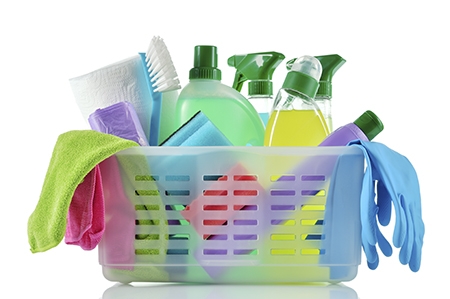OK, so you’re motivated to take that dive and break out a broom and mop. Your gloves are on and you’re ready to get cleaning. But where do you start? Which areas of the home? Inside or outside? What cleaners are best? What music will you listen to? These are all important questions, so it’s best to have a plan of attack.

Some Basics
Make a list of areas of the home you’d like to clean, set priorities and create deadlines. Not into making lists? A quick Google search for “spring cleaning list” will result in extensive checklists of Spring Cleaning projects. But if you’re just doing the basics, consider starting with these:
- Thoroughly dust your home and clean or replace air conditioning and heating filters. Clean all ducts and vents to decrease your exposure to pollens and other airborne allergens that can cause respiratory issues and lead to more serious health conditions. Remember, dust bunnies are elusive creatures and hunting them can be challenging. Removing the kickplate grille from the bottom of your refrigerator can reveal an entire family of them in the cooling coils. Ceiling fans, behind washers and dryers, and the tops of cabinets are also popular areas for dust accumulation.
- Wipe down hard surfaces. Light switches, thermostats, doorknobs, cabinet pulls, and faucet handles can be havens for bacteria to survive and thrive. They are often forgotten during the everyday cleaning regimen and can be some of the most unsanitary surfaces in your home. Using a mild disinfectant on paper towels will kill harmful bacteria and help prevent the spread of viruses.
- Organize your medicine cabinet, discarding expired medications and old prescription medications no longer in use. Your pharmacist can advise you about the best way to dispose of old medications, since tossing them into the garbage may be dangerous. Many pharmacies and clinics offer a medication take-back service for free, and many Idaho landfills participate in pharmaceutical drug disposal programs. The U.S. FDA also has issued guidelines about the safe disposal of drugs. You’ll reduce your chances of becoming victim of a medication error and gain some storage space.
- Sort your cleaning products. Now is a great time to sort through the cleaning products you’ve been accumulating for so long. Don’t hesitate to dispose of products you don’t or won’t use anymore. Newer products that didn’t live up to their promise, and older products that may have expired or “settled” should be disposed of properly. Every year, Americans generate 1.6 million tons of household hazardous waste. Many Idaho landfills hold a “household hazardous waste day” that will allow you to get rid of those nasty chemicals safely and responsibly. Also, many harsh cleaners can be replaced with safer, natural alternatives that can effectively sanitize your home without putting your family or pets at risk. When it’s time to replace a cleaner, consider choosing a “green” product.
- Check the garage and basement for old cans of paint, thinners, oils, solvents, stains, and other forms of “toxic” trash. Call your city or county sanitation department to find the location of the hazardous waste drop-off center, and get rid of anything you’re not going to use. Likewise, check under the sink and around the house for old, potentially toxic cleaning products and dispose of these. Idaho’s Department of Environmental Quality has some definitive guidelines for hazardous waste disposal.
- Clean all mold and mildew from bathrooms and other damp areas with a bleach-based cleaning product. Mold is a fungus which can trigger allergic reactions in young children and the elderly, and has been linked to more serious health conditions for sensitive groups. To learn more about household mold and the issues related to it, please read the Center for Disease Control’s web page.
- Check your rugs to be sure that rugs on bare floors have non-skid mats. Older mats that have become dusty may need to be washed or replaced to provide effective protection from falls. Outfit your bathrooms with non-skid bath mats.
- Inspect outdoor play equipment and be sure that it remains sturdy and in good repair. Pay particular attention to guardrails, protruding bolts, and other potential sources of injury. Clean equipment with non-toxic cleansers and be sure to thoroughly rinse any residue with water.
- Wash and inspect patio furniture. Starting with some mild soap and water, rinse off that Idaho dust and check the furniture for damage. Then, learn what cleaning products work best for the furniture material and finish cleaning them thoroughly.
- Check for rain gutter obstructions. Over the winter, leaves, sand from roofing shingles, and other debris can accumulate in your rain gutters, slowing or blocking the proper drainage paths. This can lead to foundation flooding and other standing-water damage. Getting on a ladder and visually inspecting your rain gutters is the best option, but you can also check for obstructions by spraying a hose onto your roof for several minutes and watch the flow of water leaving the down-spouts.
- Change the batteries in your smoke and carbon monoxide detectors. If you haven’t already, test to be sure they work properly. Collect old batteries throughout the house for disposal in a battery recycling bin, or ask your local landfill where you can recycle them.
- Clean your vehicles thoroughly. Most people don’t associate spring cleaning with car washing, but your garage and driveway will stay cleaner for longer if you remove all the gravel and dirt from your automobiles’ undercarriage. Also, clutter in your car can cause the same emotional stress as home clutter, plus it can be a safety hazard if it impedes your ability to drive without distraction.
You’ve done the basics and you’re ready to get down and dirty! Check out our complete Spring Cleaning Checklist.